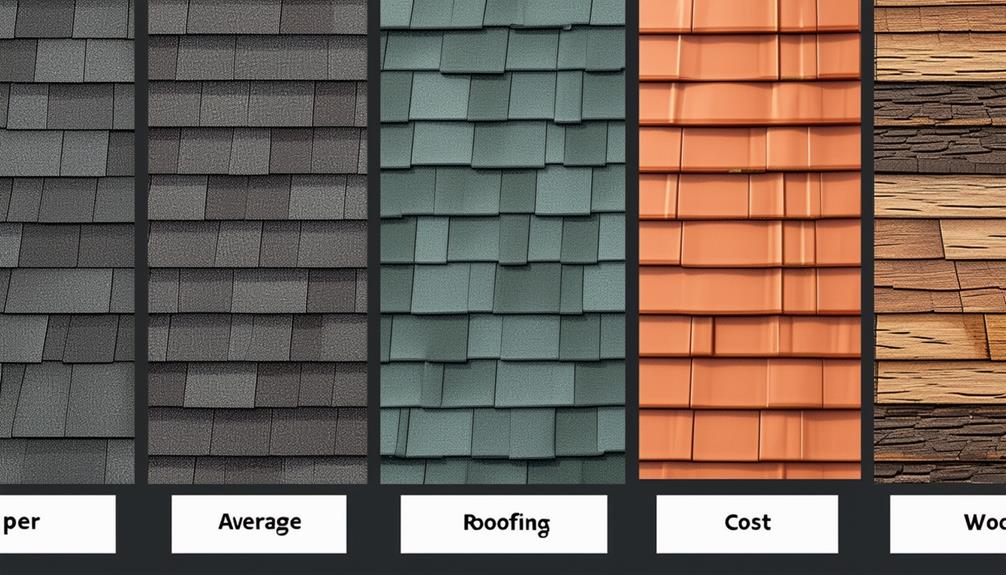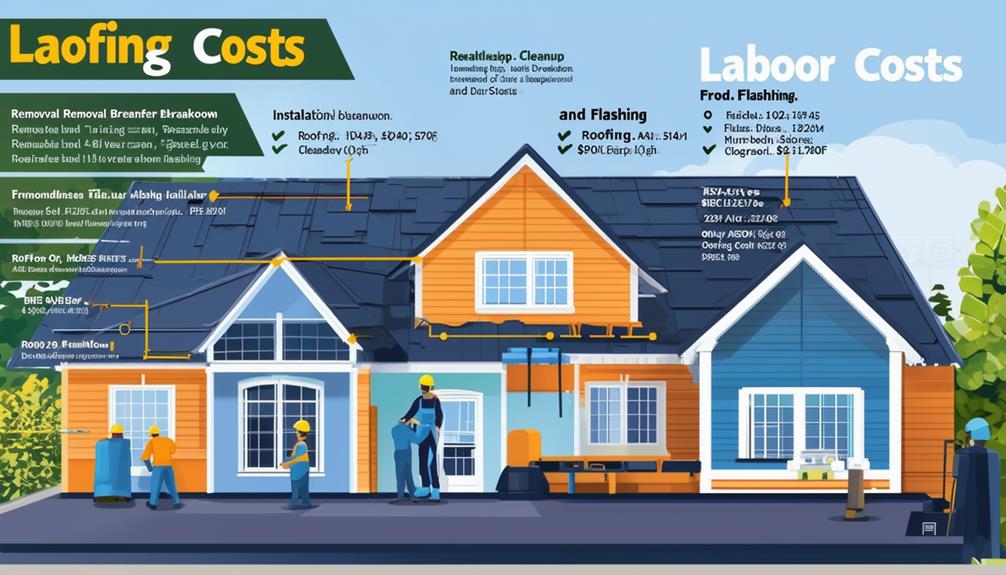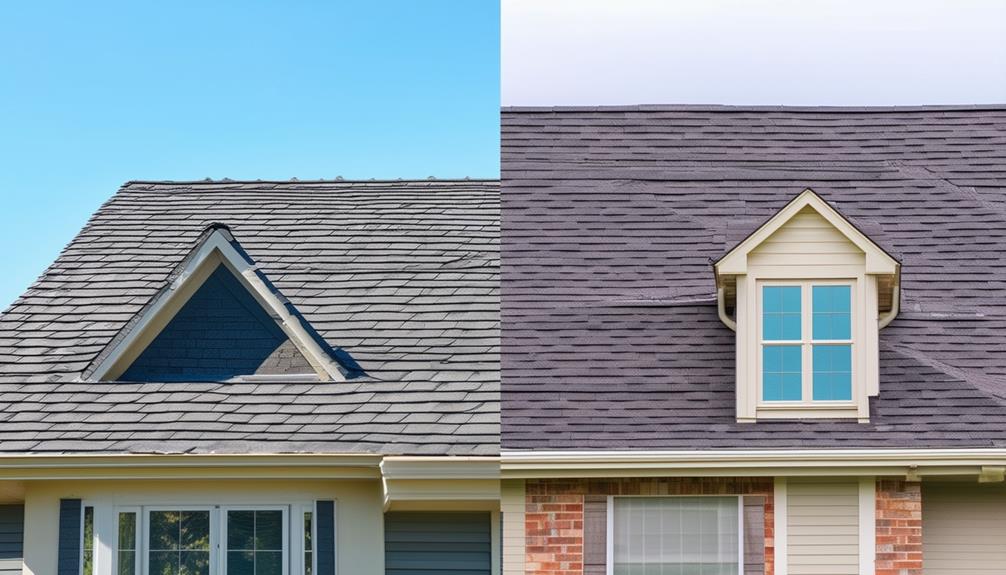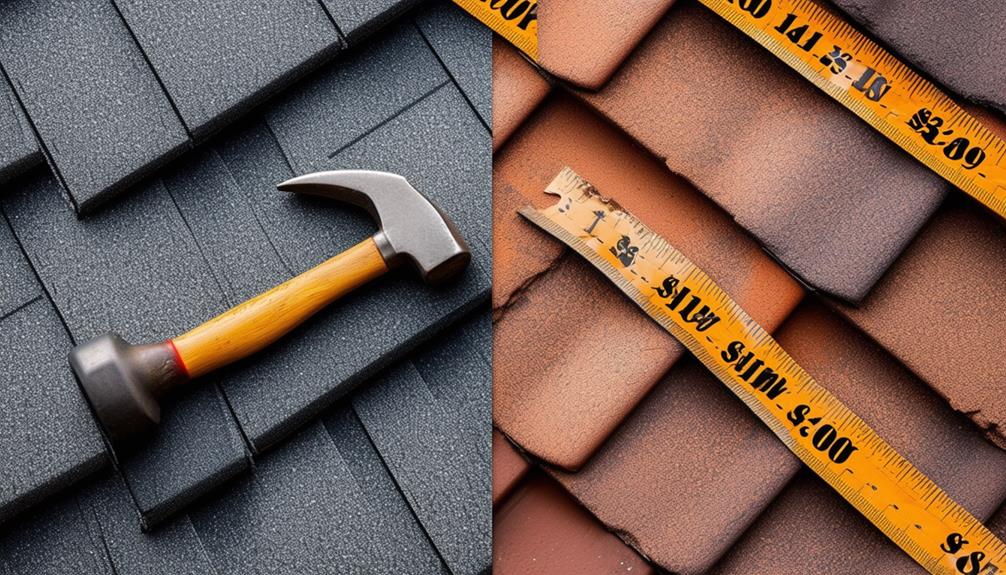When considering roofing installation costs, expect variations based on materials. Asphalt shingles range from $1.00 to $4.00 per sq ft, while metal roofing can be $5.00 to $12.00 per sq ft. Different materials impact durability, maintenance, and aesthetics, influencing expenses. Skilled labor is essential; proficient roofers command higher wages. Labor efficiency, complexity of installation, and material upgrades affect total costs. Consider additional factors like roof size, design, and local labor rates. Understanding these aspects helps in budgeting wisely. For more insights on what influences roofing costs, explore further into factors like structural issues, labor efficiency, and material upgrades.
Average Cost of Roofing Materials

What are the average costs of roofing materials in today's market? When contemplating roofing materials for your project, it is vital to comprehend the cost breakdown and make informed material comparisons. Asphalt shingles, one of the most common roofing materials, are relatively affordable, with costs ranging from $1.00 to $4.00 per square foot. On the higher end of the spectrum, metal roofing can cost between $5.00 and $12.00 per square foot, but it offers durability and longevity. Wood shingles, while aesthetically pleasing, can be pricier, typically falling in the range of $5.00 to $10.00 per square foot.
When comparing materials, it is essential to take into account not only the initial cost but also the long-term benefits and maintenance requirements. Asphalt shingles may be cost-effective initially, but they may require more frequent replacements compared to metal roofing. Wood shingles, although expensive, offer a unique look and natural insulation properties. By analyzing the cost breakdown and material comparisons, you can choose the roofing material that best fits your budget and needs.
Factors Influencing Installation Costs
When it comes to roofing installation costs, the types of materials you choose play a significant role in determining the final price. Additionally, the skill level of the laborers involved in the installation process can greatly impact the overall cost. Understanding how these factors influence pricing can help you make informed decisions when planning your roofing project.
Material Types Impact Costs
Various roofing material types have a notable impact on the overall costs of installation due to variations in durability, maintenance requirements, and aesthetic appeal. When considering roofing materials, it is important to weigh the pros and cons of each option to make an informed decision that aligns with your budget and preferences.
- Material Durability: The longevity of the roofing material plays a significant role in determining the overall cost of installation. Materials like metal and slate tend to be more durable, requiring less frequent replacements or repairs compared to asphalt shingles or wood.
- Maintenance Requirements: Some roofing materials demand more maintenance than others. For instance, wood shingles may need regular treatments to prevent rot, while metal roofs are relatively low maintenance.
- Aesthetic Appeal: The visual aspect of the roofing material can impact installation costs. Unique or high-end materials like clay tiles or cedar shake may come at a higher price point due to their aesthetic appeal.
- Environmental Impact: Certain materials, such as solar tiles or green roofs, offer eco-friendly benefits but may involve higher upfront costs.
- Weight Considerations: Heavier materials like concrete tiles may require additional structural support, potentially increasing installation expenses.
Labor Skill Affects Pricing
Competent labor greatly impacts roofing installation costs, as the expertise and efficiency of the workers involved can influence the overall pricing of the project. Skill level analysis plays an important role in determining labor costs, with highly skilled roofers often commanding higher wages due to their proficiency and experience. Roofing companies may factor in the skill level required for a particular project when estimating labor costs, as more complex installations demand workers with advanced skills and training.
Labor cost variations can also stem from the efficiency of the roofing crew. A team that works quickly and effectively can reduce labor costs by completing the project in less time, saving on hourly wages and potentially minimizing any additional expenses. Conversely, inexperienced or inefficient laborers may take longer to finish the job, resulting in higher labor costs due to extended work hours. When evaluating roofing installation costs, the skill level and efficiency of the labor force are key factors to take into account.
Labor Costs Breakdown

Understanding the breakdown of labor costs is essential for gaining insight into the overall expenses involved in roofing installation. When analyzing labor costs, factors such as labor efficiency, training programs, and workforce availability play an important role in determining the final expenses. Here is a breakdown of labor costs to keep in mind:
- Labor Efficiency Analysis: Conducting a labor efficiency analysis can help identify areas where productivity can be improved, leading to potential cost savings.
- Cost Saving Strategies: Implementing cost-saving strategies, such as optimizing workflow processes and utilizing technology, can help reduce labor expenses.
- Training Programs: Investing in training programs for employees can enhance their skills and efficiency, ultimately impacting labor costs positively.
- Workforce Availability: Ensuring a sufficient workforce availability is essential to prevent delays and additional costs associated with prolonged project timelines.
- Monitoring Labor Costs: Regularly monitoring and adjusting labor costs based on project progress and efficiency can help maintain budget adherence throughout the roofing installation process.
Additional Costs to Consider
When planning for roofing installation, remember to factor in not only labor expenses but also potential additional costs such as material upgrades. These upgrades can greatly impact the overall cost of your roofing project, so it's important to carefully consider your options and budget accordingly. By accounting for these extra expenses from the outset, you can guarantee a more accurate estimate of the total cost of your roofing installation.
Labor Expenses
How much should you budget for labor expenses when contemplating roofing installation costs? Labor expenses can have a profound impact on the overall cost of your roofing project. Factors such as labor efficiency and installation timelines play a vital role in determining the final expenses. Here are some key points to keep in mind:
- Labor Efficiency: The effectiveness of the roofing crew can affect the overall labor costs. A skilled and experienced team may complete the installation faster, potentially reducing labor expenses.
- Installation Timelines: The length of time it takes to install the roof can impact labor costs. Delays in the installation process can lead to increased labor expenses.
- Complexity of the Roof: The complexity of your roof design can impact labor costs. Intricate designs or steep slopes may require more labor hours, increasing expenses.
- Local Labor Rates: Labor rates can vary depending on your location. Be sure to factor in local wage rates when budgeting for labor expenses.
- Additional Labor: Any extra labor required for tasks such as removing old roofing materials or repairing underlying structures should be accounted for in your budget.
Considering these factors can help you estimate and plan for labor expenses when budgeting for your roofing installation project.
Material Upgrades
Consider exploring material upgrades as you plan for additional costs in your roofing installation project. Opting for materials with higher durability can increase the initial investment but might save you money in the long run by reducing maintenance and repair costs. High-quality materials like metal roofing or architectural shingles offer superior durability, protecting your home from harsh weather conditions and potentially extending the lifespan of your roof.
Moreover, when considering material upgrades, it is essential to factor in installation timeframes. Some advanced roofing materials may require specialized installation techniques, leading to longer project durations. However, the extended lifespan and enhanced performance of these materials often outweigh the additional time spent on installation. Additionally, investing in materials that are quicker to install can help minimize labor costs associated with longer installation periods.
Ultimately, material upgrades play an important role in the overall cost and performance of your roofing system. By carefully evaluating the durability and installation timeframes of different materials, you can make informed decisions that align with your budget and long-term goals.
Roof Size and Complexity Impact

Understanding how the size and complexity of your roof impacts installation costs is essential for budget planning. Several factors contribute to the variations in costs based on roof size and complexity:
- Roof Pitch Variations: A steeper roof pitch often requires more labor and safety precautions, leading to higher installation costs.
- Weather Conditions Impact: Adverse weather conditions can prolong the installation process, affecting labor costs and potentially requiring additional materials.
- Roof Size: Larger roofs naturally require more materials and labor, leading to higher overall costs compared to smaller roofs.
- Complexity of Design: Intricate roof designs with multiple angles, valleys, or dormers can increase installation time and material waste, impacting the final cost.
- Structural Issues: Existing structural problems such as rot or damage may need to be addressed before installation, adding to the overall complexity and cost of the project.
Taking into consideration these factors when evaluating your roof's size and complexity will help you anticipate potential costs accurately.
Choosing the Right Roofing Material
Choosing the right roofing material is essential for ensuring durability and longevity of your roof. When selecting a material, take into account factors such as material durability, aesthetic appeal, environmental impact, and maintenance requirements.
Material durability is vital in withstanding harsh weather conditions and increasing the lifespan of your roof. Options like metal and clay tiles offer excellent durability, while asphalt shingles are a cost-effective choice with moderate durability. Aesthetic appeal is another important aspect to ponder, as the roofing material contributes greatly to your home's overall look. Wood shakes provide a rustic charm, while slate exudes a timeless elegance.
Environmental impact should also be taken into consideration when choosing a roofing material. Opt for eco-friendly options like recycled shingles or metal roofs, which are energy-efficient and recyclable. Additionally, maintenance requirements vary among materials, with some needing regular inspections and repairs to maintain their integrity. Prioritize choosing a roofing material that aligns with your budget and maintenance capabilities to ensure a long-lasting and visually appealing roof.
Budgeting Tips for Your Project

Planning your roofing installation project budget effectively is essential for a successful and cost-efficient outcome. To help you stay within your financial limits, consider the following budgeting tips:
- Cost Saving Strategies
- Compare quotes from multiple roofing contractors to make sure you are getting a competitive price.
- Opt for standard roofing materials over premium options to save on costs without compromising quality.
- Schedule your roofing project during the off-season when contractors may offer discounts.
- Regular maintenance and inspections can help prevent costly repairs in the future.
- Consider reusing any salvageable materials from your current roof to reduce waste and expenses.
- DIY Options
- If you have the necessary skills and experience, tackling certain aspects of the roofing installation yourself can reduce labor costs.
- Simple tasks like cleaning gutters or removing debris can be DIY projects to save money.
Financing Options Available
Consider exploring various financing options to help fund your roofing installation project effectively. When budgeting for your roof installation costs, payment plans and loan options can be beneficial. Some roofing companies offer payment plans that allow you to spread out the cost of your project over several months. These plans can help make the expense more manageable by breaking it down into smaller, more affordable payments.
If you prefer a more traditional financing route, loan options are widely available for home improvement projects like roofing installations. You can apply for a personal loan from a bank or credit union, or explore home improvement loans specifically designed for renovations. These loans typically have fixed interest rates and can be a good option if you need to borrow a larger sum of money for your project.
Before committing to a financing option, make sure to carefully review the terms and conditions, including interest rates and repayment schedules. By choosing the right financing option, you can make your roofing installation project more financially feasible.
Hiring a Reputable Roofing Contractor

To guarantee a successful roofing installation, finding a reputable roofing contractor is crucial. When hiring a roofing contractor, there are key factors to take into account to ensure a smooth and satisfactory experience. Here are some important aspects to focus on:
- Contractor Qualifications: Verify that the contractor is licensed, insured, and certified to perform roofing work in your area.
- Price Comparisons: Obtain detailed quotes from multiple contractors to compare prices, making sure you get a fair deal without compromising on quality.
- References and Reviews: Check online reviews and ask for references to gauge the contractor's reputation and past work quality.
- Contract Terms: Review the contract thoroughly, making certain all details, such as materials, timeline, and payment schedules, are clearly outlined.
- Communication: Choose a contractor who communicates effectively and promptly addresses any concerns or questions you may have throughout the project.
Frequently Asked Questions
Can I Install a New Roof Over the Existing One?
Yes, you can install a new roof over the existing one. Doing so can provide cost savings by avoiding the need to remove the old roof. However, it's important to evaluate the structural integrity of the existing roof. Consulting with a professional roofer is recommended to assess if this option is suitable for your specific situation. Proper installation techniques and materials are essential to guarantee a durable and safe roofing system.
How Long Does a Typical Roof Installation Take?
When considering a typical roof installation, various factors come into play. The installation timeline hinges on the size and complexity of your roof, usually taking a few days to a week. Quality work is essential for longevity and home protection. Weather can affect the schedule, potentially causing delays. To guarantee a smooth process, it's wise to discuss these aspects with your roofing contractor upfront. Additionally, understanding the roofing installation process explained by your contractor can help set realistic expectations and address any concerns. Proper communication ensures that both parties are aligned, avoiding surprises during the project. By clarifying details such as material options, potential challenges, and maintenance requirements, you can ensure your investment pays off in the long run.
What Warranties Are Included With the Installation?
When thinking about roofing installation costs, it's important to inquire about warranty coverage for roofing materials and labor costs. Make sure you compare quotes thoroughly, examining the included warranties and any potential hidden fees. A thorough warranty can provide peace of mind and protection for your investment. Prioritize transparency when discussing warranty coverage with contractors to avoid any surprises down the line.
Are There Any Eco-Friendly Roofing Options Available?
When looking into sustainable options for your roofing needs, there are many eco-friendly choices available. These options may include materials like solar panels, metal roofing, or recycled shingles. While the initial cost comparison might show a slightly higher price tag for these eco-friendly materials, the long-term benefits regarding energy efficiency and environmental impact often outweigh the higher upfront costs. Consider the overall impact on the environment when making your decision.
Do I Need to Obtain Permits for a New Roof Installation?
When planning for a new roof installation, permit requirements vary depending on your location. Generally, permits are needed to make sure that the work meets safety codes. Costs for permits can range from $100 to $500, impacting your overall expenses. Research your local regulations to determine the specific permit requirements and associated costs. It's an important step in the process that guarantees your new roof is installed correctly and up to code.
Conclusion
Now that you have a better understanding of roofing installation costs, you can confidently navigate through the process and make informed decisions. Remember, like a sturdy roof protecting your home, a well-planned budget shields you from unexpected expenses. With careful consideration of factors like materials, labor, and additional costs, you can guarantee a smooth and successful roofing project. Stay on top of your budget and watch your dreams of a beautiful roof come to life!




